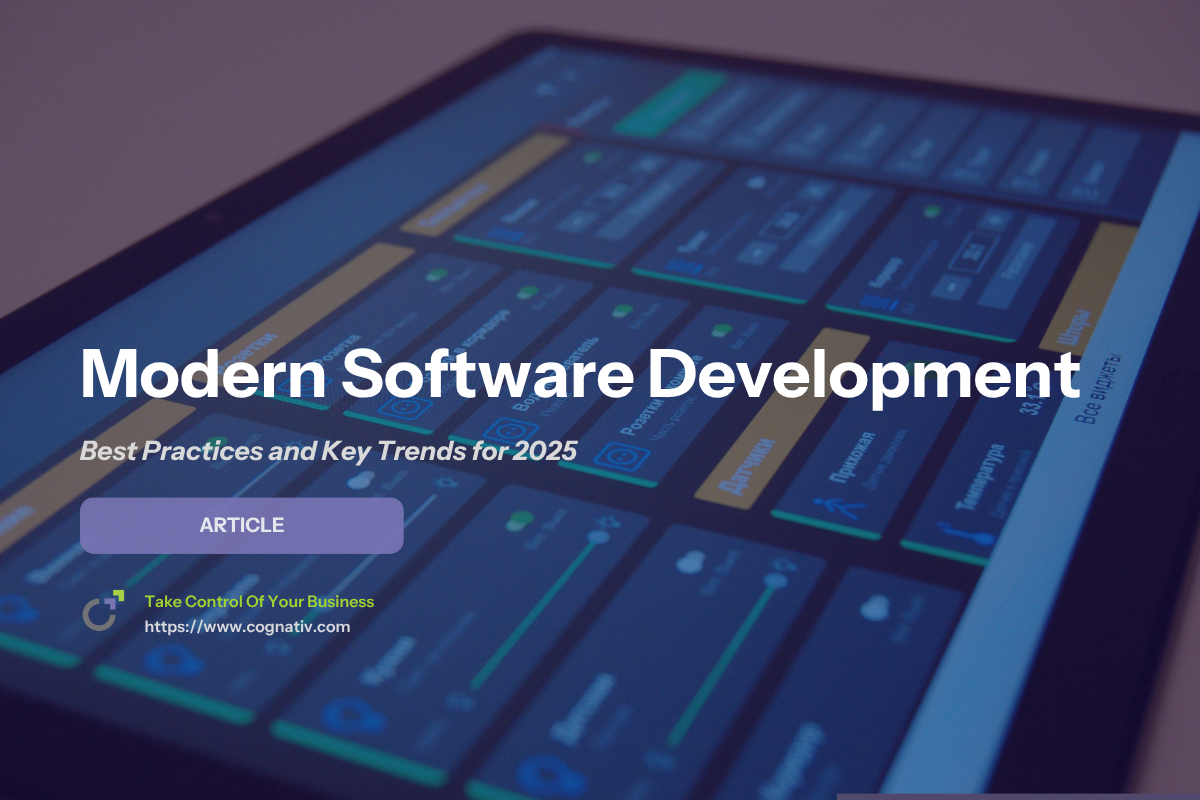Modern Software Development: Best Practices and Key Trends for 2025
Modern software development integrates agile methodologies, automation, and emerging technologies like AI and blockchain. This article delves into the best practices and trends that are shaping how software is created and deployed today.
Key Takeaways
-
Software development has shifted from rigid methodologies to agile, collaborative approaches, emphasizing rapid innovation and adaptability.
-
Key principles of modern software development include user-centric design, automation, and continuous integration, all supporting the creation of high-quality applications.
-
Emerging technologies such as AI, blockchain, and edge computing are transforming software development by enhancing application intelligence, security, and real-time processing capabilities.


The Evolution of Software Development
The landscape of software development has evolved significantly since its early days, transitioning from simple programming tasks to intricate methodologies that define modern software engineering and creating software. This evolution is not just a testament to technological advancements but also a response to the changing needs of businesses and users alike.
In the early stages, software development was often a linear, rigid process, dominated by models like the Waterfall Model. These traditional approaches had their merits but were often inflexible, making it challenging to adapt to new information or changing requirements. The cost, timeline, quality, and value delivered to end-users were heavily influenced by these methodologies. Over time, the industry recognized the need for more flexible and responsive approaches, leading to the adoption of agile methodologies and iterative development processes.
Modern application development focuses on rapid innovation cycles, which allow for the continuous delivery of new features and improvements in mobile applications. This shift has increased the agility, reliability, security, and scalability of software projects, enabling businesses to respond quickly to market demands and technological changes. Staying updated with these advancements is crucial in a field that evolves so rapidly, emphasizing the importance of faster release cycles, continuous learning, and adaptation in modern applications.
Understanding these historical shifts helps explain the emergence of agile, collaborative, and technology-driven approaches in modern software development.
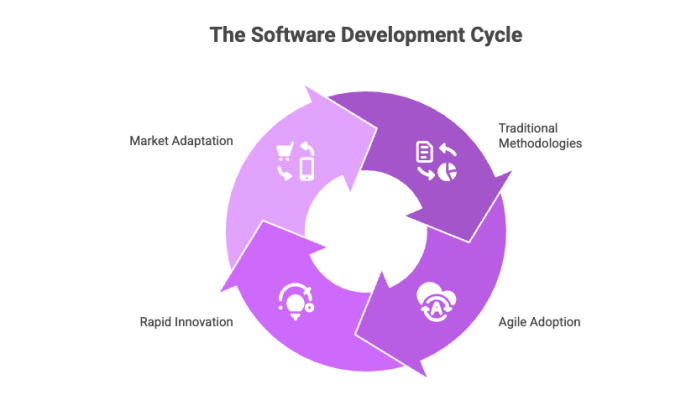

Agile and Iterative Development
Agile development emerged in the late 1990s as a response to the limitations of traditional software development models like Waterfall. The Agile Manifesto, crafted by industry leaders, emphasized the importance of valuing individuals and interactions, working software, and the ability to respond to change. This philosophy marked a significant departure from the rigid, linear processes of the past, introducing a more flexible and adaptive approach to software projects.
At the core of agile methodologies is the concept of iterative development. Teams work in short cycles, known as sprints, allowing for rapid feature delivery and the incorporation of user feedback. This iterative approach not only enhances flexibility but also reduces the risks associated with complex projects by breaking them down into manageable increments. Continuous improvement and regular evaluation are fundamental to agile, ensuring that development processes and products evolve in tandem with user needs and market conditions.
Collaboration is another cornerstone of agile development. Open communication and teamwork in agile methodologies help software development teams address challenges effectively and innovate solutions. Retrospectives, held at the end of each sprint, provide an opportunity for teams to reflect on their performance and identify areas for improvement, further reinforcing the commitment to continuous enhancement.
Prototyping and early testing are also integral to agile development. By creating initial versions of software and gathering user feedback before finalizing the product, developers can ensure that the final application meets user expectations and requirements. Proactive user engagement and feedback define agile development, distinguishing it from traditional methodologies.
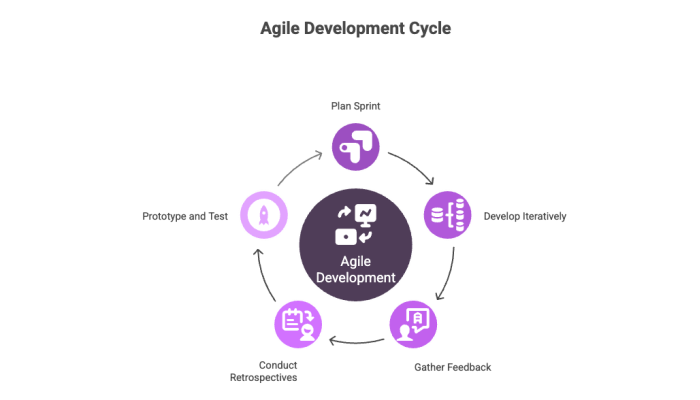

Key Principles of Modern Software Development
Modern software development is guided by several key principles and core principles that ensure the creation of high-quality, user-centric applications. One of the most important principles is user-centric design, which focuses on creating intuitive and responsive software that meets the real needs of users. Prioritizing user experience helps development teams build functional and enjoyable applications, with key considerations for usability and accessibility, including a strong user interface.
Automation plays a critical role in modern development, reducing human error and accelerating release cycles. Automated testing, continuous integration, and deployment pipelines are just a few examples of how automation can streamline the development process and ensure consistent code quality. This emphasis on automation helps teams deliver working software more efficiently and with fewer defects.
Continuous learning and customer feedback integration are also essential components of modern software development. Regularly gathering and incorporating user feedback ensures that software aligns with evolving user expectations and market demands, ultimately enhancing customer satisfaction. This iterative approach to development encourages ongoing support and improvements, fostering a culture of continuous improvement.
Collaboration among cross-functional teams is another key principle of modern software development. Enhanced collaboration among diverse skill sets and perspectives helps teams align technical execution with business objectives more effectively. This collaborative approach ensures that all aspects of the software project, from design to deployment, are well-coordinated and aligned with the overall goals of the organization.
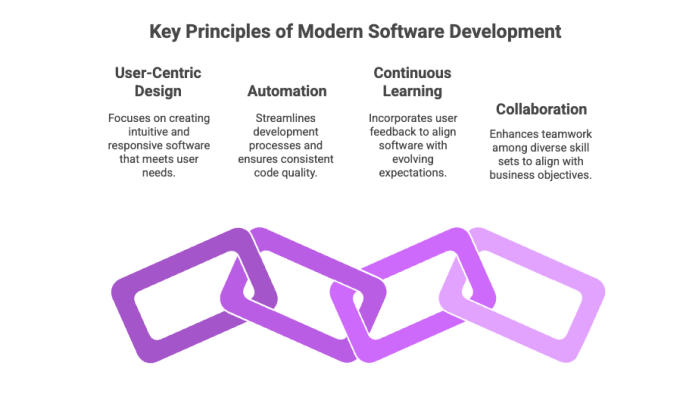

Emerging Technologies in Software Development
The rapid pace of technological advancement has introduced several key trends and emerging technologies that are transforming software development. Artificial Intelligence (AI) and Machine Learning (ML) are at the forefront of this transformation, automating tasks such as data analysis and enhancing personalization in applications. These technologies enable software developers to create more intelligent and responsive applications that can adapt to user behaviors and preferences.
Blockchain technology is another emerging trend that is making waves in the software development landscape. Blockchain fosters trust and security in applications through transparent and immutable transaction records. This technology is particularly valuable in industries that require high levels of data integrity and security, such as finance and healthcare.
Quantum computing, although still in its infancy, holds the potential to revolutionize software development by allowing faster data processing and solving complex problems through the use of qubits. As this technology continues to develop, it promises to unlock new possibilities for a software application, particularly in fields like pharmaceuticals and logistics.
Edge computing is also gaining traction as it enhances real-time data processing by bringing computation closer to the source of data. This reduces latency and allows for immediate analysis, making it ideal for applications that require rapid response times, such as IoT devices and autonomous vehicles.
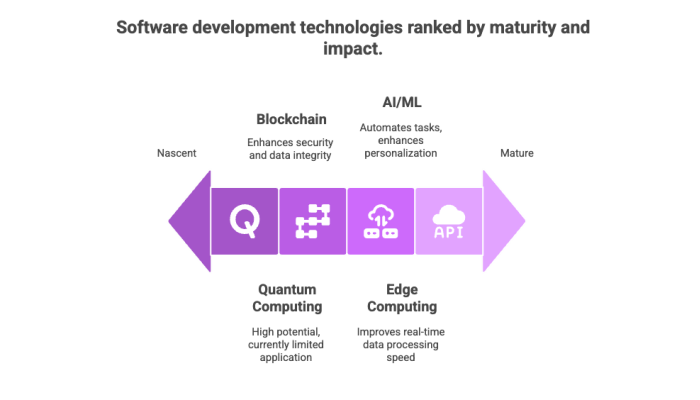

DevOps and Continuous Integration/Continuous Deployment (CI/CD)
DevOps has become a cornerstone of modern software development, emphasizing collaboration and efficiency among development teams. Breaking down silos and fostering a culture of continuous improvement, DevOps enhances the development process. One of the key components of DevOps is Continuous Integration/Continuous Deployment (CI/CD), which enables frequent code integration and reliable deployment, crucial for rapid application delivery.
Selecting the appropriate CI/CD tools is essential for optimizing development workflows and meeting project needs. Modern CI/CD tools support flexible environments, allowing builds to run in containers or virtual machines, which enhances scalability and adaptability. This flexibility is particularly valuable in cloud-native development and production environments, where rapid resource provisioning and deployment are critical.
Cloud-native development further enables faster application updates, reducing the time needed to deploy a new feature from months to minutes. This rapid deployment capability is a significant advantage in today’s fast-paced software development environment, allowing businesses to respond quickly to market demands and user feedback.
Integrating CI/CD into workflows ensures a seamless user experience and maintains high code quality. Automated testing and continuous feedback loops are integral to this process, ensuring that any issues are identified and addressed promptly, leading to more reliable and robust software applications.
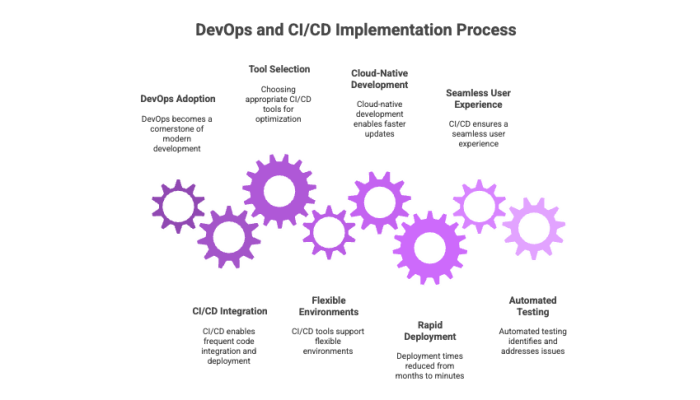

Cloud Native Development
The shift from physical servers to cloud computing has significantly transformed modern software infrastructure. Cloud-native development allows software to be easily packaged and deployed across numerous operating systems, enabling rapid deployment processes. This shift has not only improved productivity but also provided businesses with powerful IT resources and faster implementations, driving competitive advantages.
One of the main advantages of cloud-native development is its flexibility and scalability. Cloud-native applications are designed to leverage cloud infrastructure, allowing resources to be adjusted quickly to meet demand. This automated scalability ensures that applications can handle varying workloads efficiently, without the need for manual intervention, particularly in cloud native architectures.
Adopting microservices architecture enhances resilience in cloud-native applications, ensuring that the failure of one component does not disrupt the entire system. This architectural style allows for deploying services across multiple servers, reducing performance impacts and avoiding vendor lock-in. As a result, businesses can achieve greater reliability and fault tolerance in their software applications.
Cloud-native development also enables faster application updates, reducing the time needed to deploy new changes from months to minutes. This rapid deployment capability is a significant advantage in today’s fast-paced software development environment, allowing businesses to respond quickly to market demands and user feedback.
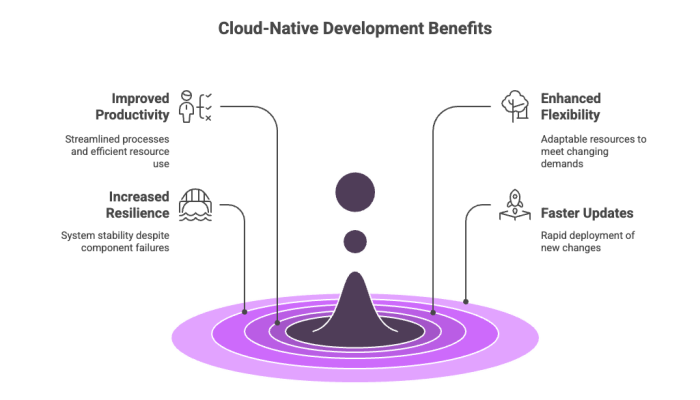

Microservices Architecture
Microservices architecture has become a popular architectural style in modern software engineering. This approach divides applications into smaller, independently deployable services that communicate through APIs, enhancing scalability and maintenance. Microservices architecture allows changes to a single service without redeploying the entire application, enabling faster development cycles and more efficient updates.
Fault isolation is a key advantage of microservices architecture. If one service fails, other services can continue to function without disruption. This resilience is crucial for maintaining high availability and reliability in complex software systems. Additionally, microservices architecture improves team productivity by enabling small teams to focus on specific services, fostering ownership and expertise.
However, managing service communication and coordinating deployments can be challenging in a microservices setup. Effective communication channels, often established through well-defined APIs, are crucial for system cohesion. Debugging can also be complex due to the distributed nature of services, requiring extensive logging and monitoring to identify and resolve issues.
Despite these challenges, the benefits of microservices architecture, such as scalability, fault tolerance, and faster development cycles, make it a valuable approach in modern software engineering. As businesses continue to adopt cloud-native development and microservices architecture, they can achieve greater flexibility and efficiency in their software applications.
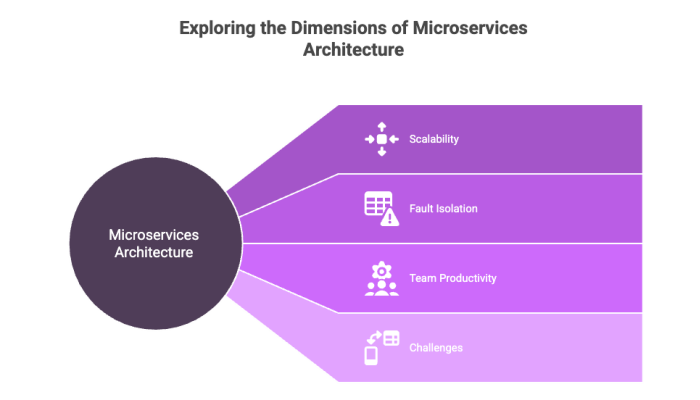

Security Practices in Modern Software Development
Incorporating robust security practices into modern software development is essential to protect applications from emerging threats. Integrating security into every phase of the software development life cycle (SDLC) ensures that vulnerabilities are identified and addressed early, reducing remediation costs and enhancing overall security.
A secure software development policy outlines the necessary practices to minimize vulnerabilities during development. This includes:
-
Employing secure coding practices
-
Conducting thorough code reviews
-
Using frameworks like the NIST Secure Software Development Framework (SSDF) to ensure consistent security measures
-
Maintaining secure code repositories with restricted access to protect software integrity.
Developers are encouraged to use secure coding practices and conduct thorough reviews to prevent vulnerabilities. AI can enhance code quality and more efficient bug detection during the development process, further strengthening security measures. Utilizing blockchain technology can also enhance security by preventing unauthorized access to software applications.
Organizations should prepare a rapid response plan for vulnerabilities to minimize the risk of exploitation. This proactive approach ensures that any security issues are quickly addressed, reducing the potential impact on users and the business.
Ingraining security into organizational culture and development processes helps software development teams combat emerging threats and ensure the integrity and reliability of their applications, enabling organizations.
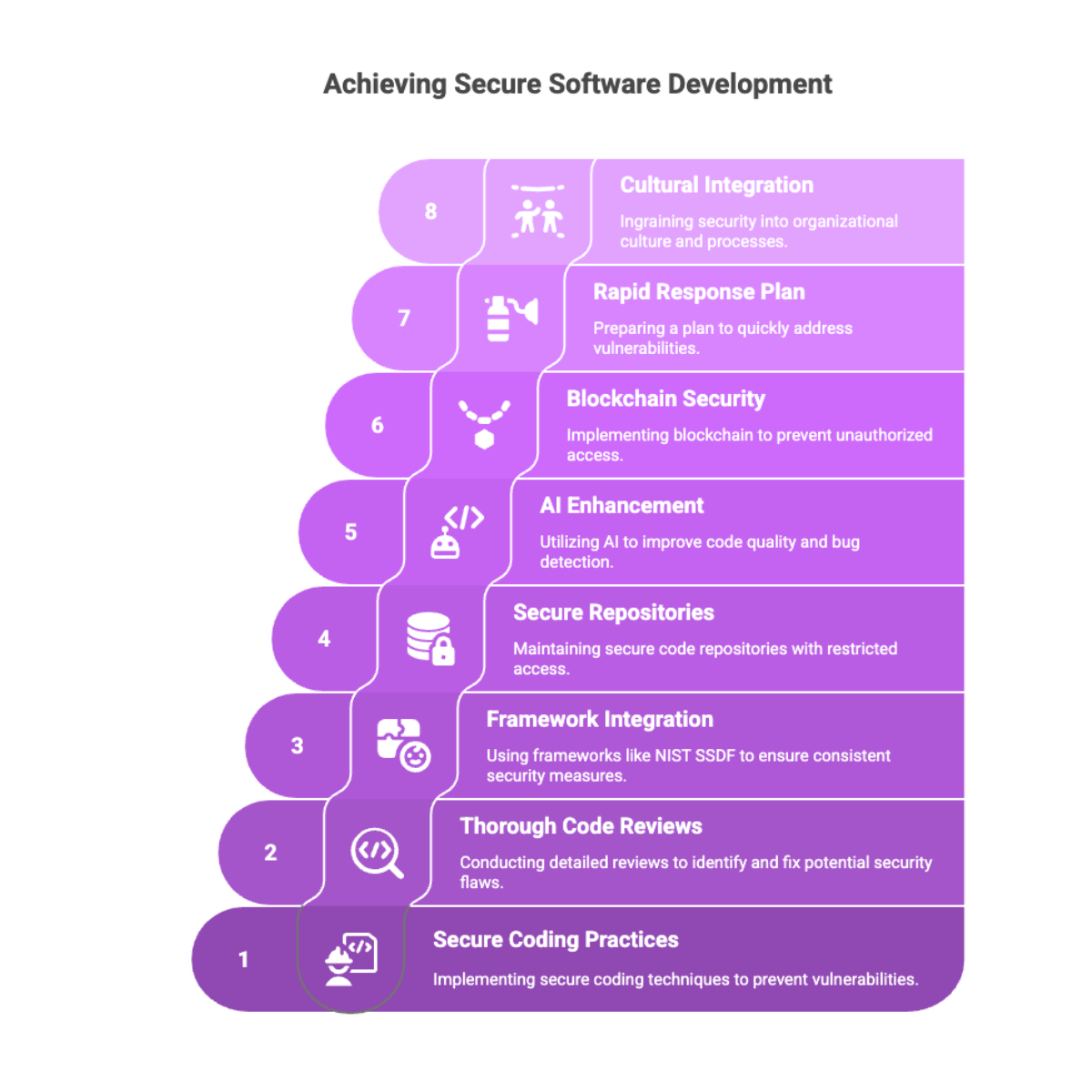

Key Roles in a Modern Software Development Team
A successful modern software development team comprises various key roles that contribute to the project requirements’ overall success. Product Managers oversee the entire development lifecycle, ensuring that the team is aligned with market success and user needs. Business Analysts gather insights on user needs and recommend product enhancements based on market analysis, bridging the gap between business objectives and technical execution.
Software Architects delineate the software’s internal structure, ensuring it meets functional requirements and is scalable and maintainable. Software engineers and engineering teams Managers cultivate team dynamics and oversee the implementation of technical solutions, fostering a collaborative and productive environment.
Software developers are responsible for writing code and bringing software concepts to life through programming. A software developer collaborates with UX/UI Designers to harmonize user experience and interface design, focusing on accessibility and aesthetics to create intuitive and engaging applications. Testers identify software defects during testing and ensure product functionality, playing a critical role in maintaining high code quality.
Scrum Masters facilitate agile processes, helping teams optimize performance and remove impediments. Team Leads manage task prioritization and maintain team morale while overseeing overall team operations. Each of these roles is essential for the smooth execution of software projects, ensuring that all aspects of the development process are well-coordinated and aligned with the project’s goals.
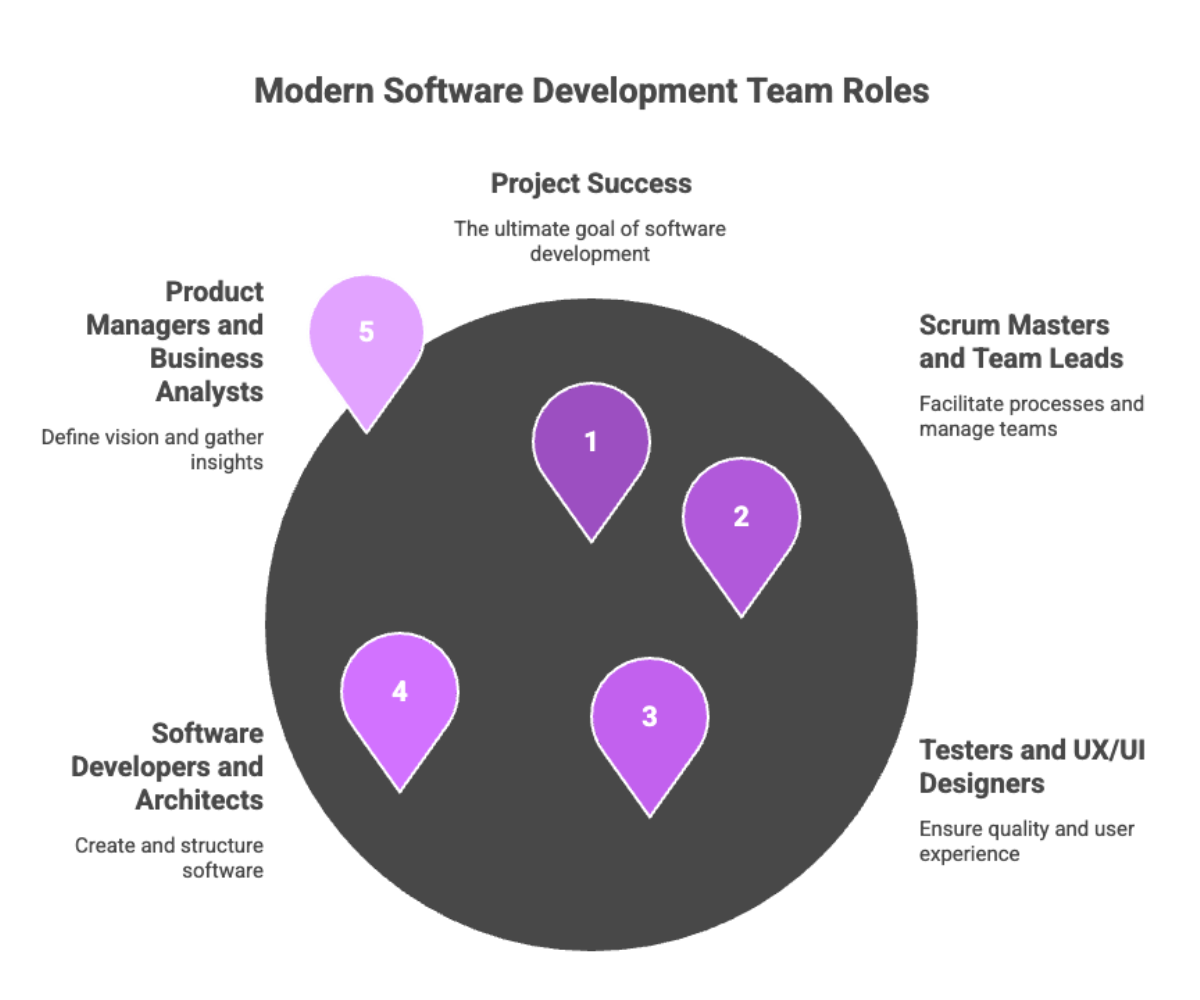

Version Control and Code Quality
Version control systems, such as Git, are foundational tools in modern software development processes. These systems allow software developers to track changes in their code, making it easier to identify issues and roll back to previous versions if necessary. This capability is crucial for maintaining the integrity of the codebase, especially when multiple developers are working on the same project.
One of the significant benefits of using version control is the facilitation of collaboration among development teams. Version control systems allow developers to work on different features simultaneously and merge changes seamlessly, keeping the entire team aligned. Git’s snapshot feature, which captures the state of the codebase at specific points, is particularly useful for managing project history effectively.
Combining version control with automated code reviews enhances code quality and ensures best practices are followed. Platforms like GitHub provide tools such as GitHub Actions, which automate workflows directly within repositories by reacting to events like pushes and pull requests. This automation helps maintain high standards of code quality and accelerates the development process.
Integrating version control systems and automated tools into workflows ensures robust, secure, and high-quality code. These practices are essential for delivering software that is reliable and maintainable in software applications.
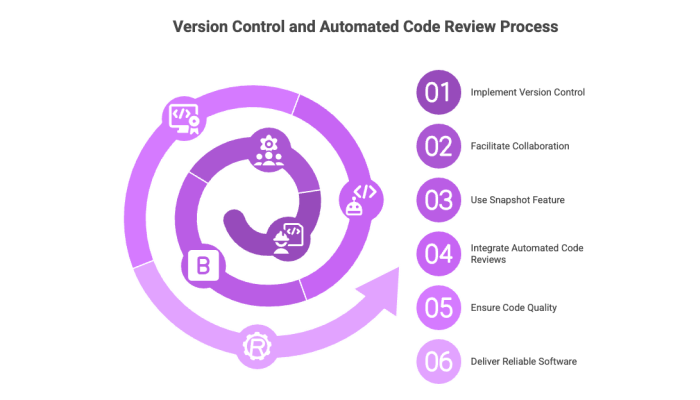

Test-Driven Development (TDD)
Test-Driven Development (TDD) is a methodology that has gained significant traction in modern software engineering. In TDD, developers write tests before writing the actual code, ensuring that the code meets specified behaviors from the outset. This approach helps in catching bugs early in the development process, reducing the time and cost associated with fixing defects later.
The TDD cycle consists of three phases: writing a failing test, writing minimal code to pass the test, and then refactoring the code for improvement. This iterative process ensures that the code is continually tested and improved, leading to higher code quality and more reliable software applications.
One of the key advantages of TDD is the boost in developer confidence it provides. Validating code through tests allows developers to make changes and refactor with confidence that their modifications will not introduce new bugs. Maintaining a swift feedback loop is crucial in TDD, allowing developers to receive immediate results from their tests and iterate quickly.
Automated tools can be integrated with version control systems to run tests, ensuring code quality before changes are merged into the main branch. Code reviews, often facilitated by these platforms, further enhance code quality by allowing team members to critique changes before they are finalized. This comprehensive approach to manual testing and quality assurance is fundamental to the success of modern software projects.
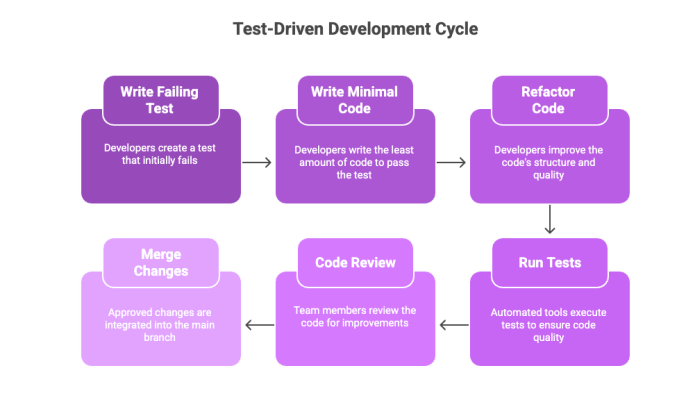

Low-Code and No-Code Development
Low-code and no-code development platforms are revolutionizing the software development landscape by simplifying the application development process.These platforms allow users to focus on meeting requirements rather than coding, significantly reducing the time and effort needed to build applications. As a result, the use of low-code/no-code platforms is projected to rise significantly, with estimates suggesting they will be involved in over 65% of global application developments by 2024.These platforms facilitate faster application development, with some methods reported to accelerate projects by up to 20 times compared to traditional coding. Organizations can save costs and achieve cost savings through the reduced time needed for development and maintenance of applications using low-code/no-code platforms. This efficiency is particularly beneficial for businesses looking to quickly adapt to new opportunities and regulatory changes.
Low-code/no-code solutions promote increased automation by enabling users to create workflows that operate across multiple information systems. Empowering non-technical users to develop applications democratizes the development process within organizations, fostering innovation and collaboration.
As the demand for rapid and flexible software solutions continues to grow, low-code and no-code development platforms will play an increasingly critical role in enabling businesses to meet their development needs efficiently and effectively.


Project Management in Modern Software Development
Effective project management is essential for the successful execution of modern software development projects. Project Managers and Scrum Masters act as navigators, ensuring smooth project progression and clarity of direction. They are responsible for coordinating tasks, managing timelines, and ensuring that the team remains focused on the project’s goals.
Business Analysts and Product Owners bridge the gap between business and technical teams, aligning solutions with business objectives and user needs. They gather insights on user requirements and market trends, providing valuable input that guides the development process. This alignment ensures that the final product meets both business goals and user expectations.
Project management tools, such as Gantt charts, kanban boards, and project calendars, are indispensable for planning and executing various project aspects. These tools help teams visualize project timelines, track progress, and manage tasks effectively. The Work Breakdown Structure (WBS) organizes project tasks into smaller, more manageable components, enhancing clarity and planning.
Risk registers and Earned Value Management (EVM) are also crucial components of project management. Risk registers track potential project risks, detailing their likelihood and impact, aiding in effective risk management. EVM integrates project scope, schedule, and cost to provide performance insights and forecasts.
A RACI chart clarifies roles and responsibilities, identifying who is responsible, accountable, consulted, and informed. These tools and techniques ensure that projects are well-managed and that teams can deliver high-quality software on time and within budget.
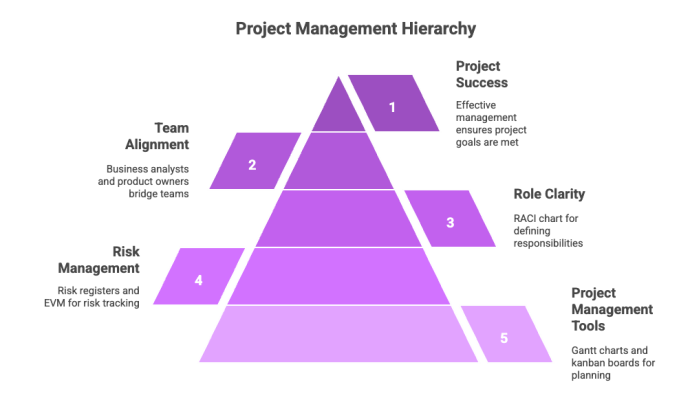

Trends Shaping Software Development in 2025
The field of software development is continually evolving, driven by rapid advancements in technology and changing business needs. One of the most significant trends shaping the industry in 2025 is the ongoing development of quantum computing. Although still in its infancy, quantum computing holds transformative potential for industries such as pharmaceuticals and logistics, enabling faster data processing and solving complex problems.
Artificial Intelligence (AI) and Machine Learning (ML) continue to play a pivotal role in modern software development. These technologies are being integrated into software applications to enhance personalization, automate tasks, and predict customer behavior. As AI and ML algorithms become more sophisticated, they will enable software developers to create more intelligent and adaptive applications.
Blockchain technology is another key trend that is gaining traction in the software development landscape. Blockchain fosters trust and security in applications through transparent and immutable transaction records, particularly in industries requiring high data integrity and security.
Edge computing is also emerging as a crucial technology for real-time data processing. By bringing computation closer to the source of data, edge computing reduces latency and allows for immediate analysis, making it ideal for applications that require rapid response times. As these technologies continue to evolve, they will shape the future of software development, enabling developers to create more innovative and efficient software solutions.
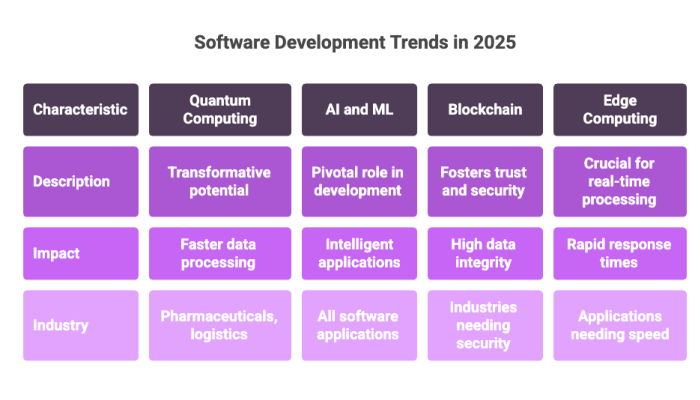

Summary
As we have explored throughout this guide, the landscape of software development has undergone significant transformations, driven by the adoption of agile methodologies, the integration of emerging technologies, and the emphasis on robust security practices. From the evolution of software development to the principles that guide modern practices, it is clear that staying current with these advancements is essential for success in this dynamic field.
By embracing agile development, leveraging the power of AI and ML, adopting cloud-native and microservices architectures, and ensuring robust security measures, software development teams can create high-quality, user-centric applications that meet the demands of today’s market. As we look to the future, staying informed about key trends and continuously improving our practices will be crucial for navigating the ever-changing landscape of software development.

Frequently Asked Questions
What is the significance of agile development in modern software engineering?
Agile development is significant in modern software engineering because it fosters flexibility and rapid iterations, enabling teams to swiftly adapt to changing requirements and deliver high-quality software that aligns with user needs. This collaborative approach ultimately enhances the efficiency and effectiveness of the development process.
How do emerging technologies like AI and ML impact software development?
Emerging technologies like AI and ML significantly streamline software development by automating tasks such as data analysis and enhancing personalization. This allows developers to create intelligent applications that better adapt to user behaviors and preferences.
What are the benefits of cloud-native development?
Cloud-native development enhances productivity, scalability, and flexibility by allowing rapid deployment across multiple servers. This significantly reduces the time to implement new changes, streamlining the development process.
Why is security important in modern software development, and how can it be ensured?
Security is crucial in modern software development to safeguard applications against evolving threats. Ensuring security involves integrating it throughout the software development life cycle, utilizing secure coding practices, performing comprehensive code reviews, and leveraging frameworks like the NIST SSDF.
What role do project management tools play in modern software development?
Project management tools are essential in modern software development as they facilitate effective planning, visualization of timelines, and task management. By using these tools, teams can ensure timely project delivery and adherence to budget constraints.

